The
Medal of Honorwas
established by Congress on July 6, 1960, as the highest
of several awards created specifically for the Air Force.
It is given in the name of Congress to officers and enlisted
members who distinguished themselves by gallantry and
intrepidity at the risk of their lives, above and beyond
the call of duty, in action involving actual combat with
an armed enemy of the United States. It is only presented
by the President and is awarded in the name of Congress
of the United States.
Award: For Conspicuous Gallantry and Intrepidity at the Risk of Life, Above and Beyond the Call of Duty, in Action Involving Actual Conflict with an Opposing Armed Force.
Medal's
Design: by Lewis J. King, Jr., of the Army's
Institute of Heraldry. It is a gold finished five pointed
star, one point down, tipped with trefoils and each
point containing a crown of laurel and oak on a green
enamel background. Centered on the star is an annular
of thirty-four stars which surround the profile of
the head from the Statue of Liberty. The star is surrounded
by a green enameled laurel wreath, edged in gold. The
medal is suspended from a design, taken from the Air
Force coat of arms. In the center is a baton with eagle
claws at both ends resting on a pair of aviator's wings
emitting thunderbolts from the center. This is attached
to a horizontal bar bearing the word "Valor." The
reverse of this decoration is blank and suitable for
engraving.
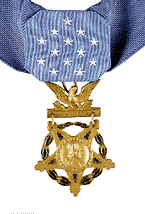
Neck
Ribbon: The Neck Ribbon passes through the bar, and
has an octagonal pad of the traditional light blue
moiré ribbon with thirteen white stars.
 Ribbon: Traditional
light blue moiré ribbon with five
white stars. Ribbon: Traditional
light blue moiré ribbon with five
white stars.
History: The
first presentation of this Medal of Honor was made at
the White House in Washington on Jan. 19, 1967, when
the President placed it around the neck of Maj. Bernard
F. Fisher, United States Air Force.
The Air Force Medal of Honor has been awarded
12 times for actions during the war in Vietnam. Three of these decorations,
to Capt. Steven L. Bennett, Capt. Lance P. Sijan and Capt. Hillard A. Wilbanks
were posthumously awarded. Two of the medals were awarded for extraordinary
heroism while the recipient's were prisoners of war, one to Captain Sijan
and the other to Col. George E. Day who was the most highly decorated officer
in the Air Force.
Others who received the medal for their actions
in the war in Vietnam are: Maj. Merlyn Hans Dethlefsen, Capt. James P. Fleming,
Lt. Col. Joe M. Jackson, Sgt John L. Levitow -- the only Air Force enlisted
member to receive the medal, Lt. Col. Leo K. Thorsness, Capt. Gerald O. Young,
and Col. William A. Jones III, who received the medal posthumously.
In addition, four other airmen received the
Congressional Medal of Honor during the Korean War. Majs. George A. Davis
Jr., Charles J. Loring Jr., and Louis J. Sebille, and Capt. John S. Walmsley
Jr., were all awarded the medal posthumously. During World War II, 35 members
of the Army Air Corps were presented the nation's top honor for their actions
during air missions.
Pension: Persons on the Medal of Honor Roll and otherwise eligible may, upon application, qualify for a special lifetime pension of $200 per month.
The medal is often called the Congressional Medal of Honor as it is awarded by the Department of Defense "in the name of Congress," although the official and correct title is Medal of Honor.
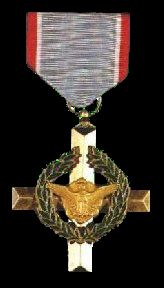 Air
Force Cross was
established by Congress, Public Law 88-593, on July
6, 1960, amended Section 8742 of Title 10, U.S. Code
to change the designation of "Distinguished Service Cross" to "Air Force Cross" in
case of awards made under Air Force Authority. This
cross, therefore, is the Air Force version of the Distinguished
Service Cross. Air
Force Cross was
established by Congress, Public Law 88-593, on July
6, 1960, amended Section 8742 of Title 10, U.S. Code
to change the designation of "Distinguished Service Cross" to "Air Force Cross" in
case of awards made under Air Force Authority. This
cross, therefore, is the Air Force version of the Distinguished
Service Cross.
Award: Awarded for
extraordinary heroism, not justifying the award of
a Medal of Honor, to any person, who while serving
with the U.S. Air Force while engaged in military operations
involving conflict with an opposing foreign force,
or while serving with friendly foreign forces engaged
in conflict against an opposing armed force in which
the United States in not a belligerent party.
Medal's
Design: by Eleanor Cox, an employee of
the Air Force and was sculpted by Thomas Hudson Jones
of the Institute of Heraldry. It is a bronze cross with
an oxidized satin finish. Centered on the obverse of
the cross is a gold-plated American bald eagle, wings
displayed against a cloud formation, (as used on the
seal of the Air Force). This design is encircled by a
laurel wreath in green enamel, edged in gold. The reverse
of the cross is blank and suitable for engraving.
History: The
first award of the Air Force Cross was a posthumous presentation
to Maj. Rudolf Anderson Jr., For extraordinary heroism
in connection with military operations against an armed
enemy from 15 October 1962 to 27 October 1962. The action
took place during the Cuban Missile Crisis. The Cross was
presented by President Kennedy to the widow of the major
at the White House.
 The Ribbon has a very wide center stripe of Brittany blue with narrow stripes of white and red at the edges. Almost identical to the Distinguished Service Cross, except for the lighter blue center stripe, indicating the close connection of these awards. The Ribbon has a very wide center stripe of Brittany blue with narrow stripes of white and red at the edges. Almost identical to the Distinguished Service Cross, except for the lighter blue center stripe, indicating the close connection of these awards.
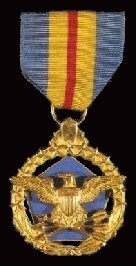
Defense Distinguished Service Medal was established by Executive Order 11545 on July 9, 1970. A rather unique feature of this decoration is that it is awarded by the Secretary of Defense and has no delegated authority. No one else can even initiate a recommendation, it is awarded solely at the initiative and pleasure of the Secretary of Defense.
Award: Awarded
to high ranking military officers (Generals or Admirals),
who perform exceptionally meritorious service in a degree
of great responsibility with the Office of the Secretary
of Defense, the Joint Chiefs of Staff, Special or outstanding
command in a Defense Agency or for any other Joint Activities
designated by the Secretary of Defense. It is rarely
awarded.
Design: by Mildred Orloff and sculpted by Lewis J. King, Jr.,
both of the Institute of Heraldry. The medal is gold
in color and on the obverse it features a medium blue
enameled pentagon (point up). Superimposed on this in
an American bald eagle with wings outspread facing left
grasping three crossed arrows in its talons and on its
breast is a shield of the United States. The pentagon
and eagle are enclosed within a gold pieced circle consisting,
in the upper half of thirteen five-pointed stars and
in the lower half, a wreath of laurel on the left and
olive on the right. At the top is a suspender of five
graduated gold rays. The reverse of the medal has the
inscription "For Distinguished Service" at
the top in raised letters, and within the pentagon
the inscription "From The Secretary of Defense
To," all
in raised letters. This decoration takes precedence
over the Distinguished Service Medals of the separate
services and is not to be awarded to any individual
for a period of service for which an Army, Navy, Air
Force or Coast Guard Distinguished Service Medal is
awarded.
 Ribbon: The
Ribbon has a center stripe of dark red flanked on either
side by wide stripes of gold and medium blue. Ribbon: The
Ribbon has a center stripe of dark red flanked on either
side by wide stripes of gold and medium blue.
History: The
first Defense Distinguished Service Medal was awarded
to Gen. Earle G. Wheeler, U.S. Army, upon his retirement
as Chairman of the Joint Chiefs Staff.
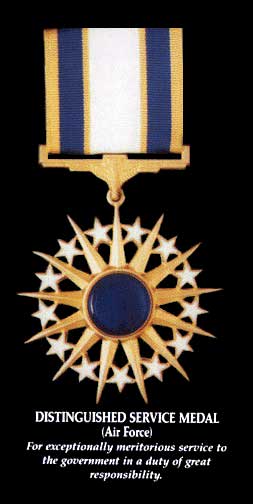
Air
Force Distinguished Service Medal was established by Congress on July 6, 1960.
Award: Awarded
to members of the United States Air Force who distinguished
themselves by exceptionally meritorious service to the
government in a duty of great responsibility, in combat
or otherwise.
Designed by Frank Alston of the Institute of Heraldry. The sunburst
design is one of the most striking examples of the medalist's
art and is a radical departure from the designs used
in the Distinguished Service Medals of the other services.
The obverse design has a sunburst of thirteen gold rays
separated by thirteen white enameled stars, with a semiprecious
blue stone in the center. The blue stone in the center
represents the vault of the heavens; the thirteen stars
represent the original colonies and man's chain of achievements.
The sunburst represents the glory that accompanies great
achievements, and the rays depict man's quest for light
and knowledge. The reverse of the medal is plain and
suitable for engraving. The star is suspended from the
ribbon by a wide slotted bar which consists of stylized
wings symbolic of the Air Force.
 Ribbon: The Ribbon has a wide center stripe of white flanked
on either side by a thin stripe of old gold, a wide stripe
of ultramarine blue and a narrow stripe of old gold at
the edges. Ribbon: The Ribbon has a wide center stripe of white flanked
on either side by a thin stripe of old gold, a wide stripe
of ultramarine blue and a narrow stripe of old gold at
the edges.
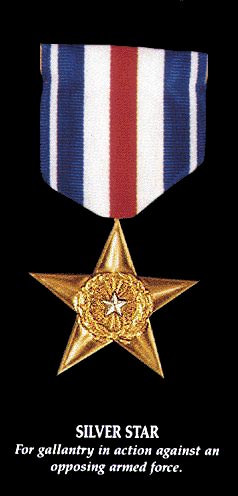
Silver Star was established by Congress on 9 JUL 18.
Award: Awarded for each Citation received by US Air Force personnel for gallantry in action not sufficient to warrant the Medal of Honor or the Distinguished Service Cross. The Silver Star is currently awarded by all branches of the armed forces to any person who, while serving in any capacity, is cited for gallantry in action against an enemy of the United States while engaged in military operations involving conflict with an opposing foreign force, or while serving with friendly forces against an opposing armed force in which the United States is not a belligerent party.
Designed
by the firm of Bailey, Banks and Biddle. On August
8, 1932, the Silver Star was re-designed as a medal
by an Act of Congress. This medal, is a gilt-toned
star of five points. On the obverse side in the center,
is a small silver star (the same size as the original
citation star), centered within a wreath of laurel.
Eighteen rays radiate from the star to the wreath.
The reverse of the star has the inscription, "For Gallantry in Action" in
raised letters, below which is a blank area suitable
for engraving the recipient's name.
 Ribbon: The
Ribbon, one of the most striking of all American
awards has a wide center stripe of red flanked on
either side by a wide stripe of dark blue, a wide
stripe of white, a thin stripe of white and a narrow
stripe of dark blue at the edges. Ribbon: The
Ribbon, one of the most striking of all American
awards has a wide center stripe of red flanked on
either side by a wide stripe of dark blue, a wide
stripe of white, a thin stripe of white and a narrow
stripe of dark blue at the edges.
History: The
Silver Star Medal had its beginning during World
War I. An Act of Congress of July 9, 1918, authorized
the wearing by Army personnel of a small silver star,
3/16 of an inch in diameter, upon the service ribbon
of a campaign medal, to indicate "a citation for gallantry in action, published in orders issued from headquarters of a general officer, not warranting the award of a Medal of Honor or Distinguished Service Cross." Known in the Army as the "citation star," the
award was made retroactive, so that all those cited
for gallantry in action in previous campaigns, even
as far back as the Spanish-American War, were eligible
to wear it.
It is estimated that more than 20,000 members of the Army received such citations before 1918. A similar device was authorized for Navy and Marine Corps personnel in 1920 which authorized a " special letter of commendation" to
be awarded on the recommendation of the Board of Naval Award. Receipt of
this special letter of commendation authorized its recipient to wear a small
silver star on The Ribbon of the Victory Medal.
Army announced that anyone who had previously
earned a Citation Star could apply for the Silver Star Medal. Navy and Marine
Corps personnel could only apply, if they were awarded a citations star by
the Army. The status of the Silver Star was further clarified, when on August
7, 1942, Congress authorized the award of the Silver Star to any person who,
while serving in any capacity with the Navy since December 6, 1941, distinguished
himself by gallantry and intrepidity in action, but not of a nature to justify
the award of the Navy Cross. Four months later, on December 15, 1942, the
decoration was extended to Army personnel for gallantry in action, but not
of a degree to justify an award of the Distinguished Service Cross.
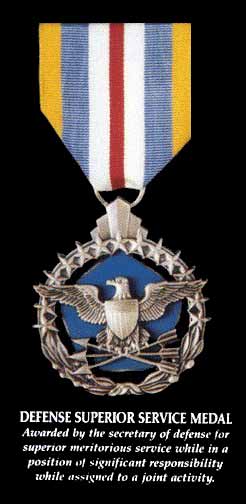
Defense
Superior Service Medal was established by Executive Order 11904 on February 6, 1976, when President Gerald R. Ford signed the order formally establishing this award.
Award: Awarded
by the Secretary of Defense to military officers who perform
exceptionally with the Office of the Secretary of Defense,
The Joint Chiefs of Staff, special or outstanding command
in a defense agency or any other joint activity designated
by the Secretary. The service rendered will be similar
to that required for award of the Legion of Merit.
Design: by Mildred Orloff and sculpted by Lewis J. King,
Jr., both of the Institute of Heraldry. In the center
is a silver-rimmed, light blue enameled pentagon. Surrounding
this, at the top, are thirteen five-pointed stars, and
at the base is a wreath of laurel and olive leaves, superimposed
on the pentagon and wreath, is an American eagle facing
left with wings outstretched, holding three arrows in
its talons. The reverse is inscribed at the top "For
Superior Service" and on the pentagon, "From
The Secretary of Defense To."
 The
Ribbon, has a narrow center stripe of red, flanked
on either side by equal stripes of white, light blue and
gold. The
Ribbon, has a narrow center stripe of red, flanked
on either side by equal stripes of white, light blue and
gold.
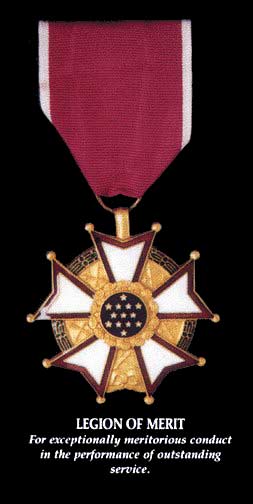 The
Legion Of Merit was
established by Congress on 20 JUL 42, in four degrees: Chief Commander, Commander, Officer, and Legionnaire; for award to personnel of Armed Forces of friendly foreign nations and personnel of the Armed Forces of the United States and the Philippines. Awarded for actions since the Presidential The
Legion Of Merit was
established by Congress on 20 JUL 42, in four degrees: Chief Commander, Commander, Officer, and Legionnaire; for award to personnel of Armed Forces of friendly foreign nations and personnel of the Armed Forces of the United States and the Philippines. Awarded for actions since the Presidential
Proclamation
of Emergency, 8 SEP 39.
Award: For
Exceptionally Meritorious Conduct in the Performance
of Outstanding Service. Created specifically for award
to citizens of other nations, conferred on officers
and enlisted men of the armed forces of the United
States and on nationals of other counties "who shall have distinguished themselves by exceptionally meritorious conduct in the performance of outstanding services" since September 8, 1939, the date of the President's proclamation of the state of emergency that led to World War II. The Legion of Merit may be awarded for combat or noncombat services; in the case of American military personnel, if the award is for combat service it is shown by the wearing of a combat "V."
Designed by COL Townsend Heard, USA.
History: The
Legion of Merit established by Act of Congress of 20
JUL 42, amended by an executive order of March 15, 1955.
The Legion of Merit was originally ranked directly below the Distinguished Service Medal in the Navy's pyramid of honor." This
was changed by Navy directive number 49 of January 28, 1946, which placed
the Legion of Merit immediately below the Silver Star, thus making it the
Navy's fifth ranking decoration.
The Legion of Merit is also the first award
to have different degrees. If a holder of the Legion of Merit in one degree
is subsequently given another such award, it is never in a degree lower than
the original one. The degrees of Chief Commander and Commander are conferred
on members of foreign governments only and are awarded for services comparable
to those for which the Distinguished Service Medal is given to members of
the United States armed forces.
This is as close as the United States has
come to creating an Order of the European type. It is the first specific
decoration awarded to foreigners and the first decoration of the United States
to be awarded in different degrees as follows:
- Chief Commander; usually awarded to Heads of Foreign States
- Commander; usually awarded to Supreme Commanders of Foreign Military
- Officer; usually awarded to Officers of Foreign Military
- Legionnaire; usually awarded
to Officers of the United States Military.
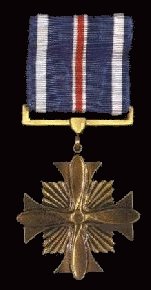 Distinguished Flying Cross was established by an Act of Congress of July 2, 1926 (amended by Executive Order 7786 on January 8, 1938), for award to any person who, serving any branch of the service including the National Guard and the Organized Reserves after 6 APR 17: For Heroism or Extraordinary Achievement while Participating in Aerial Flight. Distinguished Flying Cross was established by an Act of Congress of July 2, 1926 (amended by Executive Order 7786 on January 8, 1938), for award to any person who, serving any branch of the service including the National Guard and the Organized Reserves after 6 APR 17: For Heroism or Extraordinary Achievement while Participating in Aerial Flight.
Award: This
medal is awarded to any officer or enlisted man of the
armed forces of the United States who shall have distinguished
himself by "heroism or extraordinary achievement while participating in an aerial flight, subsequent to November 11, 1918." The
decoration may also be given for an act performed prior
to November 11, 1918, when the individual has been
recommended for, but has not received the Medal of
Honor, Distinguished Service Cross, Navy Cross, or
Distinguished Service Medal.
Subsequent awards of the Distinguished Flying
Cross are indicated by oak-leaf clusters for Army and Air Force personnel
and by additional award stars for members of the Naval services.
During wartime, members of the armed forces
of friendly foreign nations serving with the United States are eligible for
the D.F.C. It is also given to those who display heroism while working as
instructors or students at flying schools.
Design: by Elizabeth Will and Arthur E. DuBois. It is
a bronze cross pattee, with rays between the arms of
the cross. On the obverse is a propeller of four blades,
with one blade in each arm of the cross and in the re-entrant
angles of the cross are rays which form a square. The
cross is suspended by a rectangular-shaped bar and
centered on this is a plain shield. The reverse is
blank and suitable for engraving the recipients name
and rank.
When this decoration was originally created
there was a movement to have this awarded in different classes, and though
this idea was never approved, some copies of the higher class were made,
they are the same design as the approved Distinguished Flying Cross, slightly
larger, and with a pin attached to the reverse, so that it would be worn
as a breast decoration. This class was never approved and was never officially
awarded.
 The Ribbon has a narrow red center stripe, flanked on either
side by a thin white stripe, a wide stripe of dark
blue, a narrow white stripe and narrow dark blue at
the edge of The Ribbon. Bronze V device worn to denote
Valor/Heroism. The Ribbon has a narrow red center stripe, flanked on either
side by a thin white stripe, a wide stripe of dark
blue, a narrow white stripe and narrow dark blue at
the edge of The Ribbon. Bronze V device worn to denote
Valor/Heroism.
History: The
Distinguished Flying Cross was awarded first to Captain
Charles A. Lindbergh, of the U.S. Army Corps Reserve,
for his solo flight of 3600 miles across the Atlantic
in 1927, a feat which electrified the world and made "Lindy" one of America's most popular
heroes. The first D.F.C. to be awarded to a Navy man
was to Commander Richard E. Byrd, of the U.S. Navy
Air Corps, on May 9, 1926, for his exciting flight
to and from the North Pole. Both these famous aviators
also received the Medal of Honor with the Distinguished
Flying Cross. The Aviatrix Amelia Earhart also received
the Distinguished Flying Cross. Hers was the only such
award, as an executive order on March 1, 1927, ruled
that D.F.C. should not be conferred on civilians.
An example of the gallantry for which the Distinguished Flying Cross is awarded took place on the morning of August 31, 1969 in Vietnam. Captain Francis J. Cuddy, USMC a Helicopter pilot, was assigned the mission of assisting in the extraction of an Army Special Forces reconnaissance team heavily engaged in combat with a large North Vietnamese Army deep in an mountainous area under the enemy's complete control. Captain Cuddy, undaunted by the heavy volume of hostile fire directed at his aircraft, directed other helicopters into the area, moved his aircraft into treetop level and delivered repeated rocket and strafing runs on the enemy positions. As a result of his devastating attacks, the hostile fire was suppressed and sufficiently to enable the transport helicopters to safely extract the reconnaissance team. The citation for his award went on the say "... Captain Cuddy's courage, superior airmanship, and unwavering devotion to duty in the face of personal danger were instrumental in accomplishing this hazardous mission and were in keeping with the highest traditions of the Marine Corps and of the United States Naval Service." Captain Cuddy was also awarded the Silver Star, three Distinguished Flying Crosses, Commendation Medal with Combat "V," the
Purple Heart and forty eight Air Medals During his tour of duty in Vietnam.
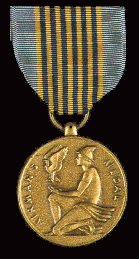
Airman's
Medal was established by Congress on 6 JUL 60, for
Heroism by those serving with the United States Air
Force in any capacity that Involves the Voluntary Risk
of Life under conditions Other Than Those of Conflict
with an Opposing Armed Force.
Award: This
decoration, one of several Air Force awards established
by Congress, and takes the place of the Soldier's Medal
for Air Force personnel. It is awarded to any member
of the armed forces of the United States or of a friendly
nation who, while serving in any capacity with the
United States Air Force after the date of the award's
authorization, shall have distinguished himself or
herself by a heroic act, usually at the voluntary risk
of his or her life but not involving actual combat.
The same degree of Heroism is required as
for the Distinguished Flying Cross.
Design: by and sculpted by Thomas Hudson Jones of the Institute
of Heraldry. On the obverse of the circular medal is
the figure of the Greek god Hermes, son of Zeus, resting
on one knee. He has just released from his open hands
a falcon, shown rising into flight. Within the raised
rim of the medal, is the inscription "Airman's Medal" in raised letters. The reverse of the medal, has a raised outer edge and bears the inscription, "For Valor" above
a space for the recipient's name which is within a
stylized laurel wreath open at the top and tied at
the bottom.
The Airman's Medal is unique in that its shape
does not follow the octagonal shape of its counterparts, the Soldier's Medal,
Navy and Marine Corps Medal and the Coast Guard Medal. It had been established
practice heretofore to design military decorations with a distinctive shape,
so that they would not be confused at a distance with service or campaign
medals, which are always circular in shape. The reason for this is because
the design was originally approved for use as The Air Force Distinguished
Service Medal.
 Ribbon: The
Ribbon is based on that of the Soldier's Medal but
using different colors. In the center are alternating
thin stripes of gold and dark blue (seven gold and
six dark blue), bordered at the edges with wide stripes
of pale (sky) blue. Ribbon: The
Ribbon is based on that of the Soldier's Medal but
using different colors. In the center are alternating
thin stripes of gold and dark blue (seven gold and
six dark blue), bordered at the edges with wide stripes
of pale (sky) blue.
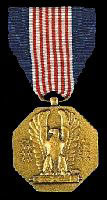
Soldier's
Medal awarded for heroism not involving actual
conflict with an armed enemy of the United States.
Award: To
Army and Air Force.
 Ribbon
Ribbon
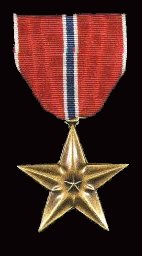 Bronze
Star Medal was established by Executive Order No. 0410
on 4 FEB 44, awarded to personnel of the US Armed Forces,
who on or after 7 DEC 41, distinguished themselves
For Heroic or Meritorious Achievement of Service, not
involving aerial flight, in connection with Operations
Against an Opposing Armed Force. Bronze
Star Medal was established by Executive Order No. 0410
on 4 FEB 44, awarded to personnel of the US Armed Forces,
who on or after 7 DEC 41, distinguished themselves
For Heroic or Meritorious Achievement of Service, not
involving aerial flight, in connection with Operations
Against an Opposing Armed Force.
Award: The
award recognizes acts of heroism performed in ground
combat if they are of lesser degree than that required
for the Silver Star. It also recognizes single acts
of merit and meritorious service if the achievement
or service is of a lesser degree than that deemed worthy
of the Legion of Merit; but such service must have
been accomplished with distinction.
Design: Designed
by the firm of Bailey, Banks and Biddle, is in the
shape of a five-pointed star 1 1/2 inches from point
to point. In its center is a smaller raised star. The
small star is set on a raised ten-pointed figure, from
which rays extend to the points of the outer star,
giving the whole a sculptured effect. The reverse of
the medal also has a raised center, with rays extending
to the five points of the star. Inscribed on this are
the words "Heroic or Meritorious Achievement,'
encircling a blank space for the recipient's name.
 The Ribbon is predominately red, with a narrow blue center
stripe flanked on either side by a narrow white stripe,
and a narrow white stripe at the outer edge. A bronze "V" on
The Ribbon denotes combat service. The Ribbon is predominately red, with a narrow blue center
stripe flanked on either side by a narrow white stripe,
and a narrow white stripe at the outer edge. A bronze "V" on
The Ribbon denotes combat service.
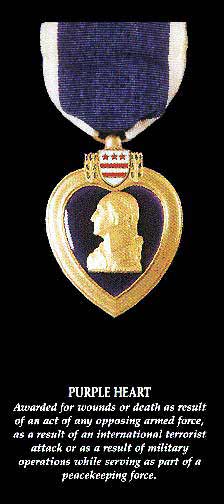
The
Purple Heart Medal today, is the modern form of the original
Purple Heart established by General George Washington
in 1782, and is conferred on any person wounded in
action while serving with the armed forces of the United
States. It is also awarded posthumously to the next
of kin of personnel killed or having died of wounds
received in action after April 5, 1917.
Award: The Purple Heart is awarded for combat action only, to any member of the Armed Forces killed or wounded in an armed conflict. Second and subsequent awards of the Purple Heart are denoted by a gold star for Navy and Marine Corps personnel and by an oak-leaf cluster for Army and Air Force personnel.
Designed by
Elizabeth Will and modeled by John R. Sinnock. The heart-shaped
medal, one of the best known and also one of the most
beautiful of our decorations. The inner heart on the
obverse is of purple plastic (originally enamel), and
the sculptured outer heart of gold-colored metal. On
the purple heart General Washington is shown in profile,
facing left, in a relief also of gold-colored metal.
Above this heart is Washington's coat of arms, and enamel
shield of white with two horizontal bands of red, and
above them three red stars with sprays of green leaves
on either side of the shield.
The reverse of the medal is entirely of gold-colored metal, including the shield and leaves. Within the sculptured outer heart and below the shield is the inscription, set in three lines, "For Military Merit," with
a space below for the recipient's name.

The Ribbon is deep purple with narrow white edges.
History: Originally established by GEN George Washington
on 7 AUG 1782, at Newburgh on the Hudson, New York,
as an award for outstanding military merit, or the
'Badge of Merit'. The decoration was in the form of
an embroidered, heart-shaped badge of purple cloth
and only three non-commissioned officers received the
Order at that time. Though never officially abolished
it was not again awarded for almost one hundred and
fifty years.
Upon its revival in 1932, as the Purple Heart,
the decoration was to be awarded to members of the US Army in two categories:
- For being wounded in action in any war or campaign under conditions which entitle the wearing of a wound chevron.
- "For those
persons who perform any singularly meritorious
act of extraordinary fidelity or essential service."
In 1942, President Franklin D. Roosevelt issued an Executive Order which provided that the Purple Heart would be made available to members of all the US Armed Services who were wounded in action. Since then the Purple Heart has become one of the most highly respected decorations of the US Armed Forces. The decoration holds a very unique position in that it can be earned in only one way, by being wounded. An attendant requirement is that the wound must have been received as a direct result of enemy actions.
 Defense
Meritorious Service Medal was established by Executive
Order 12019 on November 3, 1977, when President Carter
signed the order establishing it. Awarded for noncombat
meritorious achievement or service that is incontestably
exceptional and of magnitude that clearly places the
individual above his peers while serving in one of
the assignments for which the medal has been designated. Defense
Meritorious Service Medal was established by Executive
Order 12019 on November 3, 1977, when President Carter
signed the order establishing it. Awarded for noncombat
meritorious achievement or service that is incontestably
exceptional and of magnitude that clearly places the
individual above his peers while serving in one of
the assignments for which the medal has been designated.
Award: The
Defense Meritorious Service Medal is awarded Exceptionally
Meritorious Service in a Duty of Great Responsibility
while Assigned to a Joint Activity. Awarded to military
personnel serving with or assigned to a number of joint
activities including The Secretary of Defense, Organizations
of the Joint Chiefs of Staff and Headquarters of Joint
Commands. Other joint activities and specified commands
such as Military Assistance Advisory Groups and Joint
Missions; and jointly manned staffs within Allied Command
Europe, Allied Command Atlantic, the NATO Military Committee,
and military agencies associated with functions of the
military or other joint activities as may be designated
by the Secretary are also included.
The
medal was Designed by Mildred Orloff and sculpted
by Lewis J. King, Jr., both of the Institute of Heraldry.
It is a one and one-half inches in diameter overall,
consisting of a circular wreath of laurel tied with
a ribbon at the base; in the center is a pentagon shape,
superimposed over the pentagon is an American eagle
with wings upraised and overlapping the wreath, standing
on the bottom edge of the pentagon. On the reverse
the medal has the inscription, "Defense Meritorious
Service" in three horizontal lines; and around
the bottom are the words, "United States of America," with
space between for engraving the recipient's name.
 The Ribbon has three light blue and two white narrow
stripes in the center flanked by a wide stripe of white
and wide stripe of purple red edged by a narrow stripe
of white. The Ribbon has three light blue and two white narrow
stripes in the center flanked by a wide stripe of white
and wide stripe of purple red edged by a narrow stripe
of white.
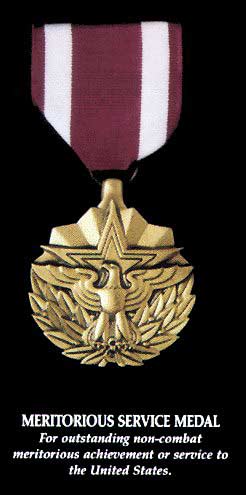
Meritorious
Service Medal was established by Executive Order 11448
on Jan. 16, 1969. The Meritorious Service Medal may
be awarded to any member of the Armed Forces of the
United States who distinguishes themselves by either
outstanding achievement or meritorious service to the
United States.
Award: Outstanding
Non-combat Meritorious Achievement or Service to the
United States. Established as the counterpart of the
Bronze Star Medal for the recognition of meritorious
noncombat service.
Designed by
Jay Morris and sculptured by Lewis J. King, Jr., both
of the Army's Institute of Heraldry. It is a one and
one-half inch medallion in bronze, on the obverse as
eagle wings upraised, standing upon two upward curving
branches of laurel tied with a ribbon between the talons
of the eagle, above and behind the eagle the upper
part of a five-pointed star (with two smaller stars
outlined within) on a incised plaque with six points
starting at the top of each wing of the eagle. The
reverse is plain with a circular inscription in raised
letters, "United States of America" and Meritorious Service" separated
by dots.
 The Ribbon is purplish red with a one and quarter inch white
stripe one-eighth inch from the edge. The Ribbon is purplish red with a one and quarter inch white
stripe one-eighth inch from the edge.
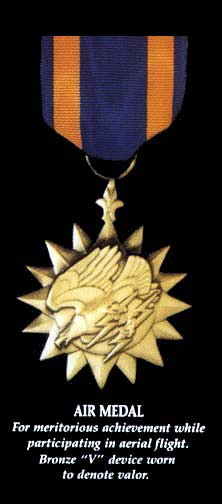 Air
Medal was established on May 11, 1942, by Executive
Order 9158 and amended by Executive Order 9242-A, on
Sept. 11, 1942, is given to any person who, while serving
with the armed forces of the United States in any capacity
subsequent to Sept. 8, 1939, shall have distinguished
themselves by meritorious achievement while participating
in aerial flight. Air
Medal was established on May 11, 1942, by Executive
Order 9158 and amended by Executive Order 9242-A, on
Sept. 11, 1942, is given to any person who, while serving
with the armed forces of the United States in any capacity
subsequent to Sept. 8, 1939, shall have distinguished
themselves by meritorious achievement while participating
in aerial flight.
Award: The Award is given for combat or non-combat action,
and conferred in recognition of single acts of heroism or merit for operational
activities against an armed enemy, or for meritorious services, or for sustained
distinction in performance of duties involving regular and frequent participation
in aerial flight. This decoration is the same for all branches of the Armed
Forces of the United States. Bronze V device worn to denote Valor/Heroism.
Subsequent awards denoted by bronze Arabic numerals.
Designed by
Walker K. Hancock, after an open competition. The medal
is a bronze compass rose of sixteen points that is surrounded
by a fleur-de-lis design in the top point. On the obverse,
in the center, is an American Eagle, swooping downward
(attacking) and clutching a lightning bolt in each talon.
The reverse has a raised disk on the compass rose, left
blank for the recipient's name and rank.
 The Ribbon has a broad stripe of ultramarine blue
in the center flanked on either side by a wide stripe
of golden orange, and with a narrow stripe of ultramarine
blue at the edge. The original colors of the Army Air
Corps. The Ribbon has a broad stripe of ultramarine blue
in the center flanked on either side by a wide stripe
of golden orange, and with a narrow stripe of ultramarine
blue at the edge. The original colors of the Army Air
Corps.
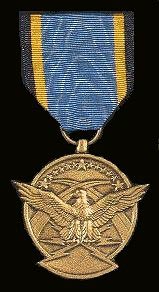
Aerial
Achievement Medal was instituted in 1988.
Award: Awarded
for sustained meritorious achievement while participating
in aerial flight. Considered on a par with the Air
Medal but more likely to be awarded during peace time.
 Ribbon Ribbon
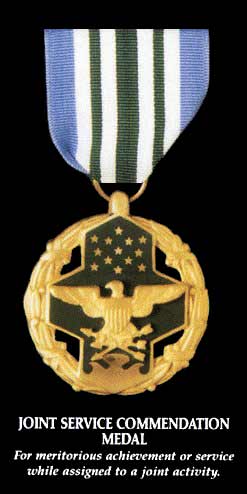 Joint
Service Commendation Medal
was
established by order of the Secretary of Defense on
17 MAY 67, as an award to any member of the US Armed
Forces who is distinguished by Meritorious Achievement
or Service while Assigned to a Joint Activity. Joint
Service Commendation Medal
was
established by order of the Secretary of Defense on
17 MAY 67, as an award to any member of the US Armed
Forces who is distinguished by Meritorious Achievement
or Service while Assigned to a Joint Activity.
Award:
The
degree of merit need not be unique but must be distinctive.
Bronze V device worn to denote Valor/Heroism in Combat.
Designed by
the Institute of Heraldry, US Air Force.
 The Ribbon has a center stripe of ultramarine blue, flanked
on either side by a wide stripe of white, with a stripe
of ultramarine blue at the center, and a narrow stripe
of blue at the edge. The Ribbon has a center stripe of ultramarine blue, flanked
on either side by a wide stripe of white, with a stripe
of ultramarine blue at the center, and a narrow stripe
of blue at the edge.
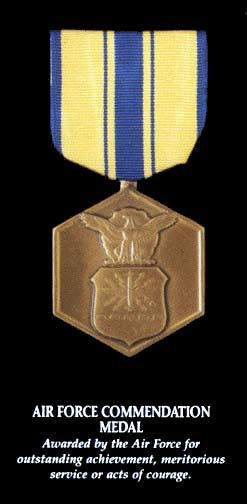
Air
Force Commendation Medalwas
established by the Secretary of the Air Force on March
28, 1958, for award to members of the armed forces
of the United States who, while serving in any
capacity with the Air Force after March 24, 1958,
shall have distinguished themselves by For Heroism,
Meritorious Achievement, or Meritorious Service
service. The degree of merit must be distinctive,
though it need not be unique. Acts of courage
which do not involve the voluntary risk of life
required for the Soldier's Medal (or the Airman's Medal
now authorized for the Air Force) may be considered
for the Commendation award.
Award: The medal is a bronze hexagon, with one point up, centered
upon which is the seal of the Air Force, an eagle with wings spread, facing
left, perched upon a baton. There are clouds in the background. Below the
seal is a shield bearing a pair of flyer's wings and a vertical baton with
an eagle's claw at either end; behind the shield are eight lightning bolts.
Bronze V device worn to denote Valor/Heroism in Combat.
An example of the citation that usually accompanies
the award of the Air Force Commendation follows: "Captain
Evans A. Kerrigan distinguished himself by meritorious service as Instructor
Navigator and Standardization/Evaluation Instructor, KC-135, 509th Air Refueling
Squadron, 509th Bombardment Wing, SAC, Pease Air Force Base, New Hampshire,
February 19, 1984 to May 16, 1988. During this period, Captain Kerrigan's
superior performance and outstanding dedication led to significant improvements
in the unit's combat readiness, contributing immeasurably to the performance
of its worldwide missions. The distinctive accomplishments of Captain Kerrigan
reflect credit upon himself and the United States Air Force."

The Ribbon has a broad stripe of ultramarine
blue in the center flanked on either side by a stripe of
golden orange, a thin stripe of blue, a broad stripe of
golden orange, and a blue border at the edge.
Designed by
the Institute of Heraldry, US Air Force.
History: Originally established by the Secretary of War as only a ribbon award in 1945, the medal was added in 1949. Awarded to members of the US Air Force, on or after 7 DEC 41.
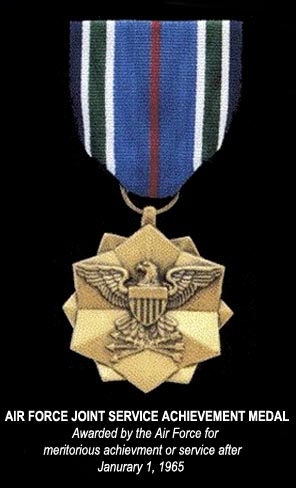 Joint
Service Achievement Medal was established by the Department
of Defense on June 25, 1963, is awarded by the office
of the Secretary of Defense, the Joint Chiefs of Staff,
and other Department of Defense agencies or joint activities
reporting through the Joint Chiefs of Staff. Any member
of the Armed Forces who distinguishes himself by Meritorious
Achievement or Service while Assigned to a Joint Activity
after January 1, 1965, is eligible for this award.
However, it will not be awarded for any period of service
for which any of the Commendation Medals of the branches
of the Armed Forces are given. Joint
Service Achievement Medal was established by the Department
of Defense on June 25, 1963, is awarded by the office
of the Secretary of Defense, the Joint Chiefs of Staff,
and other Department of Defense agencies or joint activities
reporting through the Joint Chiefs of Staff. Any member
of the Armed Forces who distinguishes himself by Meritorious
Achievement or Service while Assigned to a Joint Activity
after January 1, 1965, is eligible for this award.
However, it will not be awarded for any period of service
for which any of the Commendation Medals of the branches
of the Armed Forces are given.
Award: The
medal consists of four conjoined hexagons of green enamel.
Centered on this is an eagle in gold with outspread wings,
grasping three arrows in its talons (as depicted on the
seal of the Department of Defense). Above the eagle are
thirteen gold stars, and at the base is a gold stylized
heraldic delineation representing land, sea, and air.
This design is enclosed by a circular wreath of laurel
bound with bands, also in gold. The reverse has a tablet
in the center, suitable for engraving, and the words "FOR MILITARY MERIT." At the
bottom is a sprig of laurel.
Design: by the Institute of Heraldry, US Air Force.
 The Ribbon has a center stripe of laurel green, on either
side of which are stripes of white, green, and white,
and at the edges wide stripes of light blue. The Ribbon has a center stripe of laurel green, on either
side of which are stripes of white, green, and white,
and at the edges wide stripes of light blue.
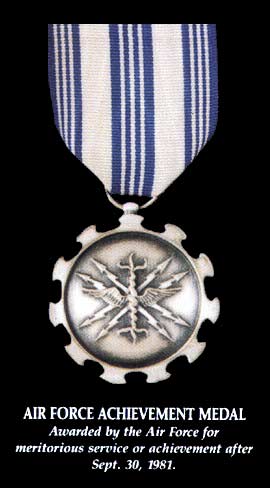
Air
Force Achievement Medal was established by the Secretary
of the Air Force on Oct. 20, 1980. It is awarded to
Air Force personnel for outstanding achievement or
meritorious service rendered specifically on behalf
of the Air Force.
Award: The medal may be awarded for acts of heroism which do not meet the requirements for award of the commendation medal.
Designed by
Capt. Robert C. Bonn, Jr., USAF. The striking medal's
distinctive outer border of this medal is composed
of 11 "cloudlike" shapes, centered on the obverse a medallion portraying thunderbolts and wings, signifying striking power through aerospace, adapted from the Seal of the Air Force. On the reverse of the medal in raised letters is the circular inscription, "Air
Force Meritorious Achievement."
 The Ribbon has three sets of four vertical stripes of ultramarine
blue on a silver gray background. The Ribbon has three sets of four vertical stripes of ultramarine
blue on a silver gray background.
 Presidential
Unit Citation (Air Force and Army) was created by Executive
Order 9075 on Feb. 26, 1942, and was superseded by
Executive Order 9396 on Dec. 2, 1943, which authorized
the Distinguished Unit Citation, and this executive
order was superseded by Executive Order 10694, on Jan.
10, 1957 which redesignated the Distinguished Unit
Citation as the Presidential Unit Citation. Presidential
Unit Citation (Air Force and Army) was created by Executive
Order 9075 on Feb. 26, 1942, and was superseded by
Executive Order 9396 on Dec. 2, 1943, which authorized
the Distinguished Unit Citation, and this executive
order was superseded by Executive Order 10694, on Jan.
10, 1957 which redesignated the Distinguished Unit
Citation as the Presidential Unit Citation.
Award: The Citation is conferred on units of the armed forces of the United States and of cobelligerent nations, for extraordinary heroism in action against an armed enemy on or after Dec. 7, 1941. The unit must display such gallantry, determination, and esprit de corps in accomplishing its mission as to set it apart from and above other units participating in the same campaign. The degree of heroism required is the same that which would warrant award of the Distinguished Service Cross to an individual.
For subsequent awards of the Presidential
Unit Citation, the individual is authorized to wear a bronze oak-leaf cluster
on The Ribbon. The same oak-leaf cluster in silver is worn in lieu of five
bronze oak-leaf clusters.
An individual assigned or permanently attached
to, and also present for duty with, a unit in the action for which the Presidential
Unit Citation is awarded may wear the emblem as a permanent part of their
uniform.
The
Army and Air Force Presidential Unit Citation is a dark blue ribbon, 1 3/8 inches wide and 3/8 of an inch high, set in a decorative gold metal frame simulating a laurel wreath.
The
Air Force Presidential Unit Citation is
slightly smaller than that of the Army, being the regulation size, so that
it can be worn in alignment with other Air Force ribbons.
 Joint
Meritorious Unit Award is authorized by the Secretary
of Defense on June 10, 1981, this award was originally
called the Department of Defense Meritorious Unit Award. Joint
Meritorious Unit Award is authorized by the Secretary
of Defense on June 10, 1981, this award was originally
called the Department of Defense Meritorious Unit Award.
Award: It
is awarded in the name of the Secretary of Defense to
joint activities for meritorious achievement or service,
superior to that which is normally expected, for actions
in the following situations; combat with an armed enemy
of the United States, a declared national emergency,
or under extraordinary circumstances that involve national
interests.
Joint Meritorious Unit Award ribbon is identical to the Department of Defense Superior Service Medal ribbon, indicative of the fact that the service performed would have been similar to warrant the award of this medal to an individual. It has a center stripe of red, flanked on either side by equal stripes of white, light blue and gold, with a narrow stripe of light blue at the edge.
The Ribbon is within a gold colored 1/16 inch wide metal
frame with laurel leaves. Similar to other Army and Air
Force unit awards, it is worn in the same manner. Additional
awards are indicated by an oak-leaf cluster worn on The
Ribbon.
 Air
Force Outstanding Unit Award was authorized by Department
of the Air Force General Order 1, Jan. 6, 1954. It
is awarded by the Secretary of the Air Force to units
which have distinguished themselves by exceptionally
meritorious service or outstanding achievement that
clearly sets the unit above and apart from similar
units.
Air
Force Outstanding Unit Award was authorized by Department
of the Air Force General Order 1, Jan. 6, 1954. It
is awarded by the Secretary of the Air Force to units
which have distinguished themselves by exceptionally
meritorious service or outstanding achievement that
clearly sets the unit above and apart from similar
units.
Award: Award
to units which have distinguished themselves by Exceptionally
Meritorious Service or Outstanding Achievement that clearly
above and apart from similar units, the services include;
performance of exceptionally meritorious service, accomplishment
of a specific outstanding achievement of national or
international significance, combat operations against
an armed enemy of the United States, or military operations
involving conflict with or exposure to hostile actions
by an opposing foreign force.
The Ribbon has a narrow red stripe, flanked by a thin white
stripe, a wide blue stripe, a thin white stripe, edged
with a narrow red stripe. A Bronze V device is worn
on The Ribbon to denote award for combat or direct
combat support actions.
 Air
Force Organizational Excellence Award was
authorized by the Secretary of
the Air Force on Aug. 26, 1969.
The Air Force Organizational Excellence award recognizes
the achievements and accomplishments of U.S. Air Force
organizations or activities that do not meet the eligibility
requirements for the Air Force Outstanding Unit Award. Air
Force Organizational Excellence Award was
authorized by the Secretary of
the Air Force on Aug. 26, 1969.
The Air Force Organizational Excellence award recognizes
the achievements and accomplishments of U.S. Air Force
organizations or activities that do not meet the eligibility
requirements for the Air Force Outstanding Unit Award.
Award: Awarded
to Air Force internal organizations that are entities
within larger organizations. They are unique, unnumbered
organizations or activities that perform functions
normally performed by numbered wings, groups, squadrons,
etcetera.
The
award is a Ribbon with a narrow blue center stripe,
flanked by a thin white stripe, a wide red stripe,
a thin white stripe, edged with a narrow blue stripe.
A Bronze V device is worn on The Ribbon to denote award
for combat or direct combat support actions.
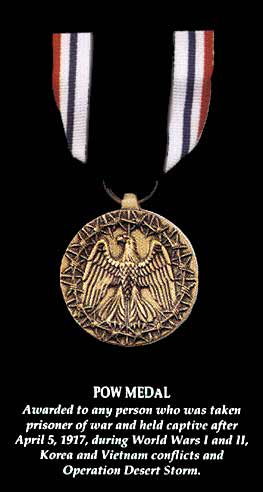
Prisoner
Of War Medal was authorized by Congress and signed
into law by President Reagan in 1986. The medal may
be awarded to any person who was a prisoner of war
after April 5, 1917 (the date of the United States
entry into World War One).
Award: Awarded
to any person who was taken prisoner or held captive
while engaged in an action against an enemy of the United
States; while engaged in military operations involving
conflict with an opposing armed force; or while serving
with friendly forces engaged in armed conflict against
an opposing armed force in which the United States is
not a belligerent party. The person's conduct, while
in captivity, must have been honorable. This medal may
be awarded posthumously to the surviving next of kin
of the recipient.
Designed by
Jay C. Morris of the Institute of Heraldry. On the obverse
of the medal is an American eagle, wing folded, and completely
enclosed (imprisoned) by a ring a circle and following
the outline of the medal. The reverse of the medal has
the inscription, "Awarded To" (with a blank area for the recipient's name) "For Honorable Service While a Prisoner of War" in three centered lines. Below this is a shield of the United States, and below, following the curvature of the medal, are the words, "United
States of America."
 The Ribbon has a very wide center stripe of black, flanked
on either side by a narrow white stripe, thin red stripe,
thin white stripe and a thin stripe of dark blue at the
edge of the medal. The Ribbon has a very wide center stripe of black, flanked
on either side by a narrow white stripe, thin red stripe,
thin white stripe and a thin stripe of dark blue at the
edge of the medal.
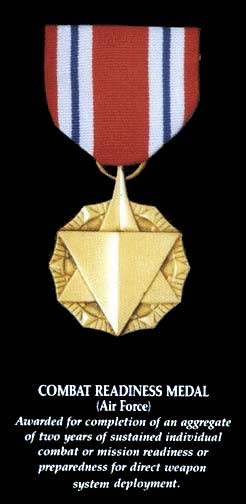 Air
Force Combat Readiness Medal was authorized by the
Secretary of the Air Force on March 9, 1964, as amended
Aug. 28, 1967. Originally created as a personal decoration
ranking above the Commendation Medals, Lifesaving Medals
and the Purple Heart, its current status has been changed
to an achievement/service medal. Air
Force Combat Readiness Medal was authorized by the
Secretary of the Air Force on March 9, 1964, as amended
Aug. 28, 1967. Originally created as a personal decoration
ranking above the Commendation Medals, Lifesaving Medals
and the Purple Heart, its current status has been changed
to an achievement/service medal.
Award: Awarded
to members of the U.S. Air Force and Air Force Reserve,
and to members of other services after Aug. 1, 1960,
for sustained individual combat or mission readiness
or preparedness for direct weapon-system employment.
Specifically, a service member must meet the following
criteria: Complete an aggregate three years of sustained
professional performance as a member of U.S. Air Force
combat or mission-ready units subject to combat readiness
reporting. Or be individually certified as combat or
mission ready and have maintained individual readiness
the entire period according to a major headquarters,
or subject to an individual positional evaluation program
according to a higher headquarters standard. The term "Combat Ready" is
defined as being professionally and technically qualified
in an aircraft crew position in an aircraft that can
be used in combat.
This
striking medal was designed by the Institute of Heraldry,
on the obverse it has an inverted triangle on top of
a delta-swept wing like object, both representing supersonic
aircraft. This design is enclosed by a stylized compass
rose with triangles at the points indicating the world-wide
nature of the mission of the Air Force. The reverse
of the medal has the inscription, "For Combat Readiness--Air Force" in
a circle, near the outer edge of the medal.
 The Ribbon has a wide center stripe of red, flanked on either
side by a narrow stripe of light blue, thin stripe of
dark blue, narrow stripe of light blue with a stripe
of red at the edge. The Ribbon has a wide center stripe of red, flanked on either
side by a narrow stripe of light blue, thin stripe of
dark blue, narrow stripe of light blue with a stripe
of red at the edge.
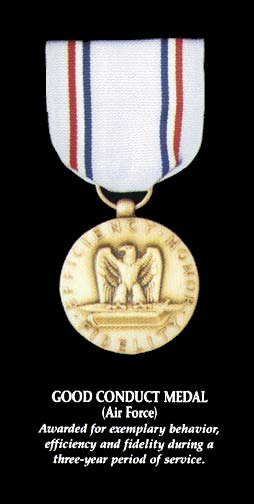 Air
Force Good Conduct Medal was authorized by Congress
on July 6, 1960, with the creation of the other medals
of the Air Force. The medal was not created until June
1, 1963 when the Secretary of the Air Force established
it. Air
Force Good Conduct Medal was authorized by Congress
on July 6, 1960, with the creation of the other medals
of the Air Force. The medal was not created until June
1, 1963 when the Secretary of the Air Force established
it.
Award: Awarded
to Air Force enlisted personnel for exemplary conduct
during a three-year period of active military service,
(or for a one-year period of service during a time of
war). Persons awarded this medal must have had character
and efficiency ratings of excellent or higher throughout
the qualifying period, including time spent in attendance
at service schools, and there must have been no convictions
of court martial during this period. Air Force personnel
who were previously awarded the Army Good Conduct Medal
and after June 1, 1963 qualified for the Air Force Good
Conduct Medal could wear both medals.
Designed by
Joseph Kiselewski. On the obverse is an American eagle
with wings displayed and inverted, standing on a closed
book and a Roman sword. Encircling this are the words "Efficiency, Honor, Fidelity" at the medal's outer edge. The reverse has a five-pointed star above a blank scroll suitable for engraving the recipient's name and above the star are the words, "For Good" and below the scroll "Conduct." Is
encircled by a wreath of laurel and oak leaves.
 The Ribbon is predominantly light blue with a tin stripe
of dark blue, thin stripe of white, thin stripe of red
and a thin stripe of light blue at the edge. The Ribbon is predominantly light blue with a tin stripe
of dark blue, thin stripe of white, thin stripe of red
and a thin stripe of light blue at the edge.
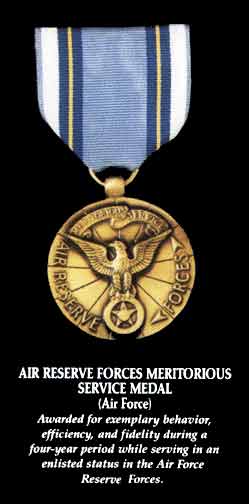 Air
Reserve Forces Meritorious Service Award was originally
established as a ribbon bar by the Secretary of the
Air Force on April 1, 1964 and was amended on May 1, 1973 when the medal was created.
Air
Reserve Forces Meritorious Service Award was originally
established as a ribbon bar by the Secretary of the
Air Force on April 1, 1964 and was amended on May 1, 1973 when the medal was created.
Award: Awarded for exemplary behavior, efficiency and fidelity during a four-year period while serving in an enlisted status in the U.S. Air Reserve Forces (Air Force Reserve).
This
circular bronze medal was designed by the Institute
of Heraldry. In the center of the obverse is an American
eagle, wings outstretched perched on a wide circle
containing a five-pointed star with a disk in the center
(like the symbols on early U.S. Aircraft). Above the
eagle and between its wing tips is a banner with the
words, "Meritorious Service." Around the edge to the left are the words, "Air Reserve" and to the right, the word "Forces" with delta wing shapes on either side of the word. Behind this design are thirteen rays or lines from the center. The reverse of the medal has a cloud design in the center and within this at the top are the wings and thunderbolts of the Air Force Coat of Arms. Below this is the word, "To," and encircling the outer edge of the medal is the inscription, "Exemplary
Behavior--Efficiency--Fidelity."
 The Ribbon has a very wide light blue center stripe flanked
on either side by a narrow blue stripe, a thin gold stripe,
a narrow blue stripe, a wide white stripe and at the
edges a thin stripe of blue. The Ribbon has a very wide light blue center stripe flanked
on either side by a narrow blue stripe, a thin gold stripe,
a narrow blue stripe, a wide white stripe and at the
edges a thin stripe of blue.
 Outstanding
Airman Of The Year Ribbon was authorized by the Secretary
of the Air Force on Feb. 21, 1968. Outstanding
Airman Of The Year Ribbon was authorized by the Secretary
of the Air Force on Feb. 21, 1968.
Award: Awarded to enlisted members of the U.S. Air Force who are nominated by their respective major commands and separate operating agencies for competition in the 12 Outstanding Airmen of the Year Program. Award of this ribbon is retroactive to June 1960.
The Ribbon has a narrow white center stripe, flanked on either side
by a narrow dark blue stripe, a narrow orange stripe,
and very wide stripe of oriental blue. Subsequent awards
will be denoted by an oak-leaf cluster worn on The Ribbon.
 Air
Force Recognition Ribbon was authorized by the Chief
of Staff, U.S. Air Force on Oct. 12, 1980. Air
Force Recognition Ribbon was authorized by the Chief
of Staff, U.S. Air Force on Oct. 12, 1980.
Award: Awarded
to named individual Air Force recipients of special trophies
and awards except the 12 Outstanding Airmen of the Year
nominees. Bronze oak-leaf clusters will be worn on the
ribbon bar to indicate subsequent awards.
The
Award Ribbon is predominatingly light blue, with a narrow
center stripe of red, flanked on either side by a wide
stripe of light blue, and thin stripes of white and red
at the edge.

American
Defense Service Medal was instituted in 1941.
Awarded for any active duty service.
 Ribbon Ribbon
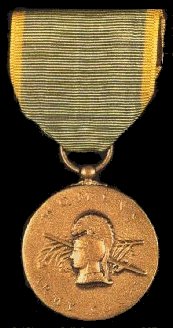
Women's
Army Corps Service Medal was instituted in 1943.
Award: Only
U.S. award authorized for women only. Service with both
the Women's Army Auxiliary Corps and Women's Army Corps
during 1941-1946.
 Ribbon Ribbon
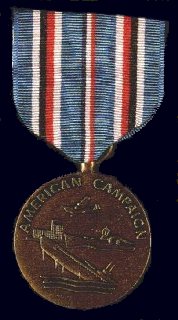
American
Campaign Medal was instituted in 1942.
Award: for service outside the U.S. in the American theater
for 30 days, or within the continental U.S. for one year.
 Ribbon
Ribbon
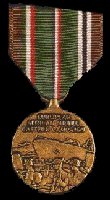
Europe-African-Middle
Eastern Campaign Medal was instituted in 1942.
Awarded for
service in the European-African-Middle Eastern theater
for 30 days or receipt of any combat decoration year.
 Ribbon Ribbon
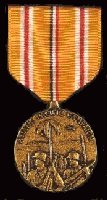
Asiatic-Pacific
Campaign Medal was instituted in 1942.
Awarded: for service outside the U.S. in the Asiatic-Pacific theater
for 30 days, or receipt of any combat decoration.
 Ribbon Ribbon

World
War II Victory Medal was instituted in 1945.
Awarded: for service in the U.S. during the period of 1941-1946.
 Ribbon Ribbon
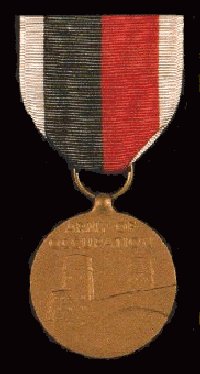 Army
Of Occupation Medal was instituted in 1946. Army
Of Occupation Medal was instituted in 1946.
Awarded for 30 consecutive days of service in occupied territories
of former enemies during the periods of 1945-1955; 1945-1990.
 Ribbon Ribbon
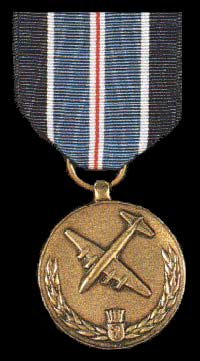
Medal For Humane Action was instituted in 1949.
Awarded for 120 consecutive days of service participating in the Berlin Airlift or in support thereof.
 Ribbon Ribbon
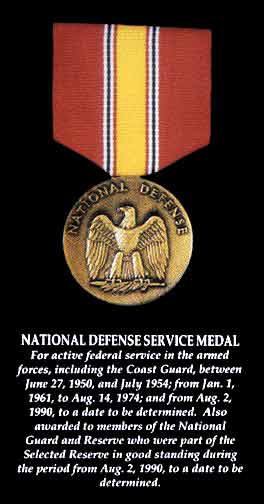
National
Defense Service Medal was authorized by Executive Order
10448, April 22, 1953, and amended by Executive Order
11256, Jan. 11, 1966.
Award: Awarded
for honorable active military service as a member of
the Armed Forces of the United States including the Coast
Guard, between June 27, 1950 and July 27, 1954, (Korean
War Period) and between Jan. 1, 1961 and Aug. 14, 1974
(Vietnam War Period). Members of the National Guard and
Reserves were not usually eligible, however if any member
of these units became eligible for the award of the Armed
Forces Expeditionary Medal or the Vietnam Service Medal,
between Jan. 1, 1961 and Aug. 14, 1974, the person would
be eligible for this medal also.
Designed by
the Army of Heraldic Section. The obverse shows the American
bald eagle, perched on a sword and palm. Above this,
in a semicircle, is the inscription "National Defense." The
reverse shows a shield, as it appears in the Great
Seal of the United States; it is half encircled below
with an oak leaf to left an laurel spray to the right,
knotted in the center.
 The Ribbon has a wide yellow stripe in the center, flanked
by narrow stripes of red, white, blue, white, wide red
stripes. Service members who earned the medal during
the first qualifying period and who again became entitled
to the medal wear a bronze star on The Ribbon to denote
the second award of the medal. The Ribbon has a wide yellow stripe in the center, flanked
by narrow stripes of red, white, blue, white, wide red
stripes. Service members who earned the medal during
the first qualifying period and who again became entitled
to the medal wear a bronze star on The Ribbon to denote
the second award of the medal.
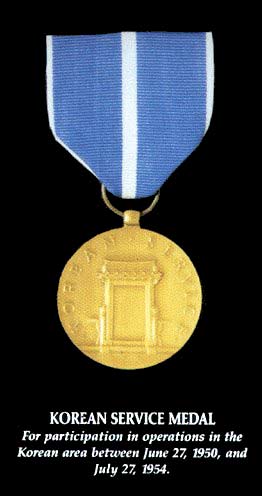
Korean
Service Medal was authorized on Nov. 8, 1950, for members
of the United States armed forces for service in Korea.
Awarded: to members of the United States armed forces for service
in Korea, 30 consecutive or 60 nonconsecutive days
between June 27, 1950, and July 27, 1954.
Designed
by the Army Heraldic Section. The obverse shows a Korean
gateway, encircled by the inscription "Korean Service." On the reverse is a symbol representing the unity of all being, taken from the national flag of Korea. Encircling this is the inscription "United States of America," with
a spray of oak at the left joined to a spray of laurel
at the right.
 The Ribbonis light blue with a thin stripe in the center
and narrow white edges--the colors of the United Nations. The Ribbonis light blue with a thin stripe in the center
and narrow white edges--the colors of the United Nations.

Antarctica
Service Medal was established by an Act of Congress
on July 7, 1960. The Ribbon was authorized in 1961,
and the design of the medal received final approval
in 1963.
Awarded to any member of the Armed Forces of the United States,
U.S. citizen, or resident alien of the United States,
who after Jan. 1, 1946 to a date to be announced, served
on the Antarctic continent or in support of U.S. operations
there. The first recipients of this award were members
of the U.S. Navy operation "High Jump" under
the late Admiral R.E. Byrd in 1946 and 1947. Deserving
civilians including scientists and polar experts can
also be awarded this medal.
Designed by
the United States Mint, is a green-gold disc. On the
obverse is a heroic figure of a man in Antarctica clothing,
with hood thrown back, arms extended, hands closed, and
legs spread to symbolize stability, determination, courage
and devotion. The figure stands on broken ground, with
clouds in the background and mountains in the far distance.
The reverse shows a polar projection map of the Antarctic
Continent, across with the words "Courage Sacrifice Devotion" set
in three centered lines, all within a symbolic circular
border of penguins and marine life.
 Ribbon Ribbon

Armed
Forces Expeditionary Medal was established on Dec.
4, 1961.
Award:
to members of the United States armed forces who, after
July 1, 1958, have participated in a United States
military operation and encountered foreign armed opposition,
or were in danger of hostile action by foreign armed
forces.
This
Design is encircled by the inscription "Armed
Forces" at the top and "Expeditionary Service" below.
Between these words, completing the circle, is a sprig
of laurel on each side. The obverse has an eagle with
wings raised, perched on a sword. In back of this is
a compass rose, with rays coming from the angles of
the compass points. The reverse has the shield as it
appears on the President's seal. Below this are branches
of laurel to right and left, joined in the center by
a knot. At the top, in a semicircle, is the inscription "United
States of America."
|
 The Ribbon has three narrow stripes of blue, white, and red
in the center, flanked by wide stripes of light blue
and, on each side, four equal stripes of black, brown,
yellow, and green. The center stripes symbolize the United
States, and the many colors at the edges symbolize the
United States, and the many colors at the edges symbolize
other areas of the world. The Ribbon has three narrow stripes of blue, white, and red
in the center, flanked by wide stripes of light blue
and, on each side, four equal stripes of black, brown,
yellow, and green. The center stripes symbolize the United
States, and the many colors at the edges symbolize the
United States, and the many colors at the edges symbolize
other areas of the world.
History: The
medal was awarded for service in South Vietnam, before
the Vietnam Service Medal was issued. This medal was
awarded for the following U.S. Military operations: Lebanon,
July 1--Nov. 1, 1958; Taiwan Straits, Aug. 23, 1958--Jan.
1, 1959; Quemoy and Matsu Islands, Aug. 23, 1958--June
1, 1963; Berlin, Aug. 14, 1961--June 1, 1963; Cuba, Oct.
24, 1962--June 1, 1963; Congo, Nov. 23--27, 1964; Dominican
Republic, April 28, 1965--Sept. 21, 1966; Korea, Oct.
1, 1966--June 30, 1974; Cambodia (Operation Eagle Pull),
April 11-13, 1975; Vietnam (Operation Frequent Wind),
April 29-30, 1975; Mayaguez Operation, May 15, 1975;
Grenada Operation, Oct. 23--Nov. 21, 1983. It was also
awarded for an operation on the Congo in direct support
of the United Nations, July 14, 1960--Sept. 1, 1962.
|
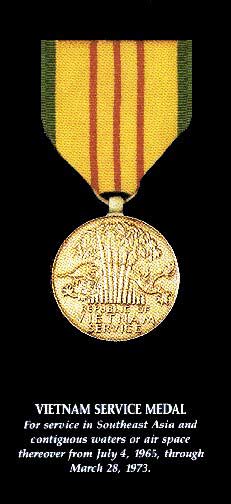
Vietnam
Service Medal was established by Executive Order 11213,
July 9, 1965.
Award: Awarded to all service members of the Armed Forces who between July 4, 1965 and March 28, 1973, served in the following areas of Southeast Asia: In Vietnam and the contiguous waters and airspace; in Thailand, Laos or Cambodia or the airspace there over or in the direct support of military operations in Vietnam.
Personnel previously awarded the Armed Forces
Expeditionary Medal for service in Vietnam between 1 July 1958 and 3 July
1965, may, upon request, exchange that medal for the Vietnam Service Medal;
however, no one is authorized to wear both medals solely for services in
Vietnam.
In effect, the authorized period of military
service to quality for the Vietnam Service Medal spans 1 July 1958 through
28 March 1973. During this period, a military member who participated in
combat or who served with a unit directly supporting a military operation
or participating in combat in Thailand, Laos, Cambodia, or Vietnam qualified
for the medal. A military member serving at least 30 consecutive or 60 nonconsecutive
days also earned the Vietnam Service Medal.
Designed by
Thomas H. Jones, a sculptor and former employee of
the Institute of Heraldry, U.S. Army. Centered on the
obverse of the medal is the figure of a dragon, behind
a grove of bamboo trees. Below this design is the inscription, "Republic of Vietnam Service." On the reverse of the medal is a cross-bow (the ancient weapon of Vietnam), surmounted by a lighted torch. Below this, along the outer edge are the words, "United States of America" in
raised letters.
The Vietnam Service Medal is worn with a suspension
ribbon, and The Ribbon bar are yellow with three vertical red stripes in
the center. The yellow, traditionally the imperial color of Vietnam, also
symbolizes the Buddhist belief, and the red stripes represent the three ancient
Vietnamese empires, Tonkin, Annam, and Cochin China. A vertical green strip
on each edge represents the Vietnamese jungles.
History: There
were 17 different campaign periods, but the first,
which was called the Vietnam Advisory Campaign, covered
the period from March 15, 1962 to March 7, 1964. During
this time there were never more than a few thousand
U.S. troops involved in Vietnam.
 The Ribbon has a thin stripe of red in the center, flanked
on either side by a narrow stripe of yellow, thin stripe
of red, wide stripe of yellow, and a narrow stripe
of green at the edges, or predominately yellow with
three red stripes at the center and green stripes at
the edges. Campaign stars were worn on The Ribbon to
indicate the number of campaigns the recipients served
in during their service in Vietnam. The Ribbon has a thin stripe of red in the center, flanked
on either side by a narrow stripe of yellow, thin stripe
of red, wide stripe of yellow, and a narrow stripe
of green at the edges, or predominately yellow with
three red stripes at the center and green stripes at
the edges. Campaign stars were worn on The Ribbon to
indicate the number of campaigns the recipients served
in during their service in Vietnam.
|
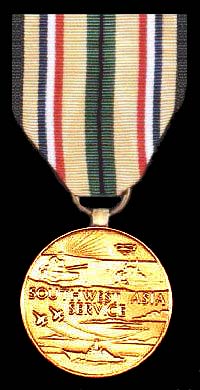
Southwest
Asia Service Medal was instituted in 1992.
Awarded for active participation in, or support of, Operations
Desert Shield and/or Desert Storm.
 Ribbon Ribbon
|
| |

Humanitarian
Service Medal was authorized by Executive Order 11965,
Jan. 19, 1977.
Award: Established
to honor personnel of the Armed Forces of the United
States who distinguished themselves by meritorious direct
participation in a significant military act or operation
of a humanitarian nature, or have rendered a service
to mankind.
Designed by Jim Hammond and sculptured by Jay Morris of the Institute
of Heraldry. Centered on the obverse of the medal within
a circle, is a right hand pointing diagonally upward
with open palm (to symbolize a giving or helping hand).
At the top of the reverse of the medal is the inscription, "For Humanitarian Service" in three lines. Below this is an oak branch, with three leaves and three acorns, and below this, around the outside edge of the medal, is the inscription, "United
States Air Forces."
|
 The Ribbon has a wide center stripe of navy blue, flanked
on either side by a broad stripe of medium blue, a thin
stripe of white, and a narrow stripe of purple-maroon
a the edges. Subsequent awards are indicated by a bronze
service star worn on the medal ribbon and ribbon bar. The Ribbon has a wide center stripe of navy blue, flanked
on either side by a broad stripe of medium blue, a thin
stripe of white, and a narrow stripe of purple-maroon
a the edges. Subsequent awards are indicated by a bronze
service star worn on the medal ribbon and ribbon bar.
History: The
number of eligible operations are too numerous to mention
and have included a wide variety of services from the
first operation of the Guyana Disaster Relief in Jonestown,
Guyana in 1978 and have included disaster, flood, tornado,
and earthquake relief work and snow removal work. Also
included were Operation Boat People, Evacuation of Laos,
Cuban Refugee Resettlement, Beirut Evacuation, Cholera
Epidemic in Truk Islands and operations of humanitarian
aid in the United States and every corner of the world.
|
|

Outstanding
Volunteer Service Medal was instituted in 1993.
Awarded: for outstanding and sustained voluntary service to the
civilian community.
 Ribbon Ribbon
|
 Air
Force Overseas Ribbon (Short Tour) Authorized by the
Chief of Staff, U.S. Air Force, October 12, 1980.
Air
Force Overseas Ribbon (Short Tour) Authorized by the
Chief of Staff, U.S. Air Force, October 12, 1980.
Award: Before
January 6, 1986, The Ribbon was awarded to Air Force and
Air Force Reserve members credited with completion of an
overseas tour on or after September 1, 1980. Air Force
and Air Force Reserve members serving as of January 6, 1986, or later are entitled to reflect all Air Force overseas
tours credited during their career. A Service member may
wear both ribbons, if appropriate.
Ribbon: The
short tour ribbon takes precedence over the long-tour ribbon
when both are worn. Subsequent awards are denoted by oak
leaf clusters.
|
 Air Force Overseas Ribbon (Long Tour) Air Force Overseas Ribbon (Long Tour)
Ribbon: The
short tour ribbon takes precedence over the long-tour ribbon
when both are worn. Subsequent awards are denoted by oak
leaf clusters.
|
|
 Air
Force Longevity Service Award The Department of the
Air Force General Order 60, Nov. 25, 1957 authorized
this ribbon. Air
Force Longevity Service Award The Department of the
Air Force General Order 60, Nov. 25, 1957 authorized
this ribbon.
Award:
to all service members of the U.S. Air Force
who complete four years of honorable active or reserve
military service with any branch of the United States
armed forces.
Ribbon: The
Air Force Longevity Service Award is a ribbon that replaces
the Federal Service Stripes previously worn on the uniform.
The Ribbon is ultrrine blue divided by four equal stripes
of turquoise. Bronze oak-leaf clusters are worn on the
ribbon to indicate subsequent awards of the Air Force Longevity
Service Award.
|
|
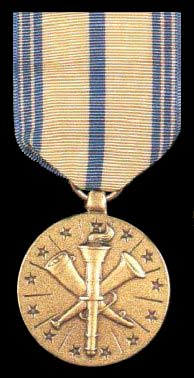
Armed
Forces Reserve Medal Authorized by Executive Order 10163 on Sept. 25, 1950, as amended by Executive Order 10439 on March 19, 1952.
Award: Armed
Forces Reserve Medal is awarded to any individual who
completes 10 years' honorable satisfactory service in
any of the reserve components of the United States armed
forces, including the National Guard, provided such service
is within a period of 12 consecutive years.
Designed by the Heraldic Branch of the Army's Quartermaster
Corps. Its obverse, which depicts a flaming torch centered
upon a crossed powder, which depicts a flaming torch
centered upon a crossed powder horn and a bugle, within
a design of 13 stars and 13 rays, is the same for all
services.
The reverse of the medal bears the circular
inscription "Armed Forces Reserve" about
a center which has a different emblem for each of the
services:
- Air Force: The Air Force emblem--an eagle, wings spread, before a circle with clouds.
- Army: A Minute Man facing left, with 13 stars in a circle behind the figure.
- Navy: A large sailing ship, seen from the side, under full sail. In front of the ship is an anchor, flukes down, with an eagle, wings spread, superimposed on it.
- Marine Corps: The Marine Corps emblem--the globe, an eagle, and an anchor.
- Coast Guard: The Coast Guard
emblem--crossed anchors with a circular plaque
upon them bearing the shield of the Coast Guard.
- National Guard: The National Guard emblem--an eagle with wings spread, crossed fasces in front of it.
|
 The Ribbon, which is the same for all the services, has a narrow
light blue center stripe, flanked with a wide buff stripe on either side,
and alternating narrow stripes of blue and buff---three of blue and two
of buff--at either edge. The Ribbon, which is the same for all the services, has a narrow
light blue center stripe, flanked with a wide buff stripe on either side,
and alternating narrow stripes of blue and buff---three of blue and two
of buff--at either edge.
History: Prior
to July 1, 1949, "satisfactory service" was
defined as honorable service in any of these units.
Since that date, a member of such a unit must be credited
with a minimum of fifty reserve retirement points per
anniversary year in order to have that year apply as
satisfactory service toward the award of the Armed
Forces Reserve Medal.
|
|
 NCO
Professional Military Education Graduate Ribbon: Authorized by the Chief of Staff, U.S. Air Force, October 12, 1980. NCO
Professional Military Education Graduate Ribbon: Authorized by the Chief of Staff, U.S. Air Force, October 12, 1980.
Award: Before
January 6, 1986, The Ribbon was awarded to Air Force
and Air Force Reserve members credited with completion
of an overseas tour on or after September 1, 1980. Air
Force and Air Force Reserve members serving as of January
6, 1986, or later are entitled to reflect all Air Force
overseas tours credited during their career. A Service
member may wear both ribbons, if appropriate.
|
|
 Air
Force Basic Military Training Honor Graduate Ribbon was authorized by the Chief of Staff, U.S. Air Force on April 3, 1976. Air
Force Basic Military Training Honor Graduate Ribbon was authorized by the Chief of Staff, U.S. Air Force on April 3, 1976.
Award: Awarded
to honor graduates of Basic Military Training who, after
July 29, 1976, have demonstrated excellence in all phases
of academic and military training and limited to the
top 10 percent of the training flight.
Ribbon: The USAF Ban Mê Thuột Honor Graduate Ribbon was designed by the Institute of Heraldry, and is awarded to basic training graduates only. The Ribbon has a wide center stripe of ultramarine blue flanked with equal stripes of yellow, Brittany blue and white on either side.
|
|
 Air
Force Small Arms Expert Marksman Ribbon was authorized by the Secretary of the Air Force on Aug. 28, 1962. Air
Force Small Arms Expert Marksman Ribbon was authorized by the Secretary of the Air Force on Aug. 28, 1962.
Awarded to
all U.S. Air Force service members who, after Jan. 1, 1963, qualify as "expert" in small-arms marksmanship
with either the M16 rifle or .38 caliber pistol. These
rules will apply to the Air Force standard service small
arms weapon selected. Qualifications as "expert" in
both weapons after June 22, 1972, shall be denoted
by a bronze service star worn on The Ribbon.
The Ribbon has a very wide center stripe of laurel green,
flanked on either side by a thin yellow stripe, with
a wide light blue stripe at the edges.
|
|
 Air
Force Training Ribbon was authorized by the Chief of Staff, U.S. Air Force on Oct. 12, 1980. Air
Force Training Ribbon was authorized by the Chief of Staff, U.S. Air Force on Oct. 12, 1980.
Award: to U.S. Air Force service members on completion of initial
accession training after Aug. 14, 1974.
The Ribbon was designed by the Institute of Heraldry. The
ribbon has a wide center stripe of red, flanked on either
side by a wide stripe of dark blue and a narrow yellow
stripe edged by a narrow dark blue stripe.
|
|

Philippine
Defense Ribbon was instituted in 1945.
Award: for service in defense of the Philippines between 8 December
1941 and 15 June 1942.
 Ribbon Ribbon
|

Philippine
Liberation Ribbon was instituted in 1945.
Award:
for
service in Liberation of the Philippines between 17 October
1944 and 3 September 1945.
 Ribbon Ribbon
|
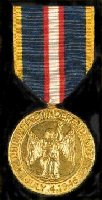
Philippine
Independence Medal was instituted in 1946.
Award:
for
receiving both the Philippine Defense and Liberation Medals.
|
 Ribbon Ribbon
|
| |
|
 Philippine
Presidential Unit Citation Emblem was awarded to members of the Armed Forces of the United States for services culminating in the liberation of the Philippine Islands during the Second World War. The conditions were the same as would be required for award of the Presidential Unit Citation of the United States. Philippine
Presidential Unit Citation Emblem was awarded to members of the Armed Forces of the United States for services culminating in the liberation of the Philippine Islands during the Second World War. The conditions were the same as would be required for award of the Presidential Unit Citation of the United States.
The Award:
is made in the name of the President of the Republic
of the Philippines. The Ribbon is slightly larger for
the Army and worn on the right breast, for the other
services The Ribbon is the standard size.
The Ribbon has three wide stripes of equal width. Starting
from the left, a wide stripe of blue, a wide stripe of
white and a wide stripe of red. The Ribbon is enclosed
in a rectangular 1/16 inch gold frame with laurel leaves.
|
| |
|
 Republic
Of Korea Presidential Unit Citation was presented to units of the United Nations Command for service in Korea under the same conditions as would be required for the award of the Presidential Unit Citation of the United States, and it is awarded in the name of the President of the Republic of Korea. Republic
Of Korea Presidential Unit Citation was presented to units of the United Nations Command for service in Korea under the same conditions as would be required for the award of the Presidential Unit Citation of the United States, and it is awarded in the name of the President of the Republic of Korea.
Award:
is a ribbon award with acCOing citation.
The Ribbon has a broad white stripe and in the center
is a tae-guk (an ancient Korean symbol) half red and
half blue. The broad white center stripe is flanked on
either side by thin stripes of green, white, red, white,
red, white and a wide stripe of green at the edge. The
Ribbon is enclosed in a rectangular gold-colored frame
with laurel leaf designs.
|
| |
|

Republic Of Vietnam Gallantry Cross was established on Aug. 15, 1950 by the Republic of Vietnam.
Award: Awarded
for outstanding bravery by officers and enlisted men
who distinguished themselves conspicuously by gallantry
in action at the risk of life. It corresponds to the
French Croix de Guerre (which design it resembles).
The bronze cross has flared
decorative edges and two crossed swords, points up,
between the arms of the cross and superimposed on a
decorative wreath-like design -- which is really two "dragon-like" figures.
On the obverse in the center is a raised disk with
a sprig of laurel at the bottom and a map of Vietnam
in the center, which contains the inscription in Vietnamese, "In
Remembrance of Work Well Done." The
badge is suspended from an ornamental bronze plaque
which is attached to The Ribbon. The reverse of the
cross is blank.
|
 Ribbon: The
ribbon is red with a wide center stripe of gold, which
is divided by 16 very thin stripes of red.
Ribbon: The
ribbon is red with a wide center stripe of gold, which
is divided by 16 very thin stripes of red.
|
| |
|
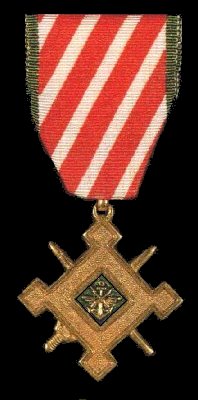
Vietnam
Civil Actions Unit Medal was
instituted in 1964.
Award: Awarded
for outstanding achievements in the field of civic actions
|
 Ribbon Ribbon
|
| |
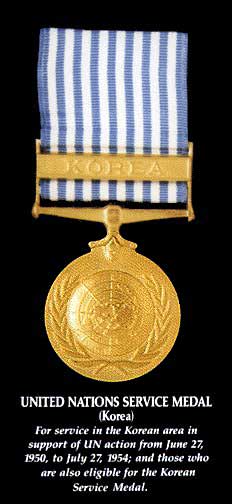 United
Nations Service Medal (Korea) was authorized by the United Nations General Assembly on Dec. 12, 1950. The Department of Defense authorized it for the United States Armed Forces on Nov. 27, 1951. United
Nations Service Medal (Korea) was authorized by the United Nations General Assembly on Dec. 12, 1950. The Department of Defense authorized it for the United States Armed Forces on Nov. 27, 1951.
Award:
to officers and enlisted men of the armed forces of the
United States who participated in the action in Korea
between June 27, 1950, and July 27, 1954. This medal
is awarded for any period of time spent in combat.
The medal, in bronze alloy, was
designed within the
United Nations, along the lines of British medals.
The obverse shows the emblem of the United Nations--a
polar projection map of the world taken from the North
Pole, encircled by olive branches. The reverse of the
medal has the inscription "For Service in Defense
of the Principles of the Charter of the United Nations" set
in five centered lines. The outer edge is a raised
rim. A bar which is permanently attached to the medal,
and through which The ribbon passes, has the word "Korea
centered thereon.
|
 The Ribbon has seventeen equal alternate stripes of pale blue and white with blue at each edge. The Ribbon has seventeen equal alternate stripes of pale blue and white with blue at each edge.
|
| |
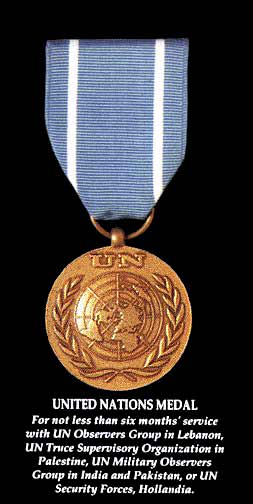 United Nations Medal was authorized by the Secretary General of the United Nations on July 30, 1959, and approved by Executive Order 11139, Jan. 7, 1964. United Nations Medal was authorized by the Secretary General of the United Nations on July 30, 1959, and approved by Executive Order 11139, Jan. 7, 1964.
Award: Awarded to service members who have been in the service of the United Nations, for a period of not less than six months, with one of the following: United Nations Observation Group in Lebanon (UNOGIL); United Nations Truce Supervisory Organization in Palestine (UNTSO); United Nations Military Observer Group in India and Pakistan (UNMOGIP) and United Nations Security Forces, Hollandia (UNSFH); United Nations Forces in the Congo, now Zaire (UNUC); United Nations Temporary Authority in New Guinea (UNTEA); United Nations Yemen Observer Mission (UNYOM); United Nations Force in Cyprus (UNFICYP); United Nations Emergency Force to observe the Israeli-Egyptian Cease-fire (UNEF 2); United Nations Disengagement Observer Force (UNDOF); United Nations Interim Force in Lebanon (UNIFIL) and the United Nations General Service Headquarters in New York.
The
medal is the same for all awards, each area of service
is identified by a different ribbon. Other organizations
may be designated by the world situation requires, and this medal will probably
continue to be awarded for future operations.
In the center of the obverse of this bronze medal is
the emblem of the United Nations, a polar projection
map of the world taken from the North Pole, with grid
lines, encircled by a wreath of olive leaves. Centered
above this are the letters, "UN." The reverse of the medal has the inscription, "In
the Service of Peace."
The medal most commonly awarded to United
States personnel would be the United Nations Observation Group in Lebanon
(UNOGIL) and the United Nations Truce Supervisory Organization in Palestine
(UNTSO), The Ribbon is identical for these services.
 The Ribbon is United Nations blue (light blue), with a
narrow white stripe one quarter inch from each edge. The Ribbon is United Nations blue (light blue), with a
narrow white stripe one quarter inch from each edge.
|
| |
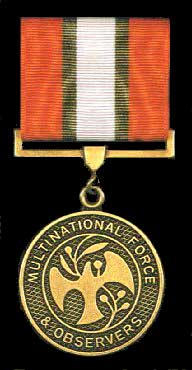
Multinational
Force and Observers Medal was
instituted in 1982.
Award: Awarded to all services members for six months service with the Multinational Force and Observers peacekeeping force in the Sinai Desert.
|
 Ribbon Ribbon
|
| |
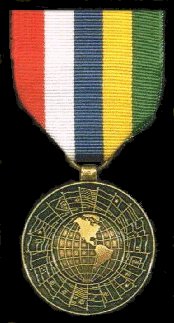
Inter-American
Defense Board Medal was instituted in 1982.
Award: Awarded
to all services members for service with the Inter-American
Defense Board Medal.
|
 Ribbon Ribbon
|
| |

Award:
was
instituted in 1966.
Award:
Awarded to all services members for six months service in the Republic of Vietnam between 1965 and 1973 or if wounded, captured or killed in action during that period of service.
|
 Ribbon Ribbon
|
| |
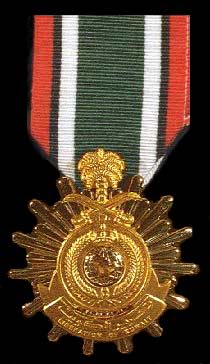
Saudi Arabian Medal For The Liberation Of Kuwait was instituted in 1992.
Award:
Awarded to all services members for participation in, or support of, Operations Desert Shield and/or Desert Storm during the period of 1991-1992.
|
 Ribbon Ribbon
|
| |
|
|
| |
|